Contributed by Brett PaddlesUpstream
Pick-up-sticks, Jackstaws (Selahtinalitin)
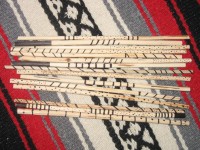
Jackstraws
Played much like the “American” games “Jackstraws” or “Pick-up-sticks”, a number of pieces are cut from bog grass or reeds, usually between 50 and 65. 15 of these are marked with pigment paint or by burning, the remaining sticks are left plain. The pieces are mixed up in the hands and dropped onto a blanket, then the 2 players take turns using a porcupine quill to collect the “sticks”, without disturbing any other sticks. The unmarked pieces are 1 point while the 15 marked pieces are 5 points, and the game is played to a predetermined number, usually 100, score is kept with seeds, corn kernels, pebbles, or whatever is available.
Indian Dice Game (Mamantuhwin)
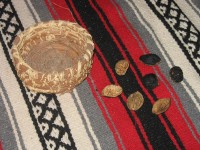
Dice Game
5 or 7 “dice” are made from peach pits, deer bone, or shell, one side being colored and the other uncolored. 2 players, or teams (often clans would play against each other) would chose their “color” and then take turns, placing the dice in a bark bowl, or something similar, and tossing the dice into the air so they would land on a blanket, score was tallied buy counting the number of dice that came up in his or her color, for example: if the person representing the color black tossed the dice and 4 came up black and 3 came up unmarked this person or team would receive 4 points. The rules and score keeping varied from person to person and community to community.
Cup and Pin, Rabbit-tail Game (Kokolesh)
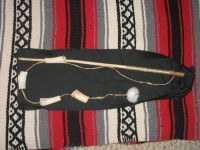
Cup and Pin / Rabbit Tail
A children’s game where a hollowed out bone, stiff hide or leather, or later a tin cone with a rabbit tail attached was attached to a sharpened stick with a piece of sinew. The goal was to toss the “cup” into the air and catch it on the end of the stick.
Moccasin Game (Chipahkwinaletin)
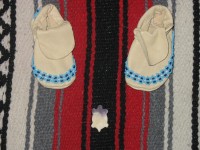
Moccasin Game
Traditionally played during the night during the funeral rite, teams or individuals would play against one another. A pair of moccasins are used and one player hides the wampum game piece in one of the moccasins and the opposing team, or person has to guess which moccasin the piece is in. Score is kept by using something non-living such as pieces of thread, cloth, or something similar, this is symbolic of the time of death. The entire time the game is being played there are specific songs that are sung in sets of 12, a sacred number among the Lenape/Delaware. This game was last played in this form around 1894, however the songs survive today as a “social dance” among the Iroquois People. In the West the game was replace by a social game called “hand game”, where a small round stone is put in one hand the other team/person guesses which hand it is in, a variation is 2 stones one “marked”, the other is not and the other team or person guesses which one is marked. In social games anything can be used to keep score, such as beans, corn kernels, or seeds.
Hoop and Pin, Hoop and Dart (Tatkusk)
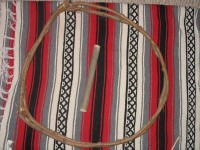
Hoop and Pin Game
A hoop made of grape vine is rolled on the ground and each person takes a turn at trying to throw a “dart” through the hoop. Darts from the size of an ear of corn to 3-4 foot “spear” blanks were used. This was considered “practice” for young boys in hunting skills. This is a commonly practiced sport among most Native People across North America and elsewhere, among certain tribes and even purported among the Lenape was the use of corn cobs as darts, however this was probably not used among most Lenape children and communities because of the high regard for corn in Lenape culture.





